tow MAZDA MODEL 3 4-DOOR 2012 User Guide
[x] Cancel search | Manufacturer: MAZDA, Model Year: 2012, Model line: MODEL 3 4-DOOR, Model: MAZDA MODEL 3 4-DOOR 2012Pages: 528, PDF Size: 6.47 MB
Page 233 of 528
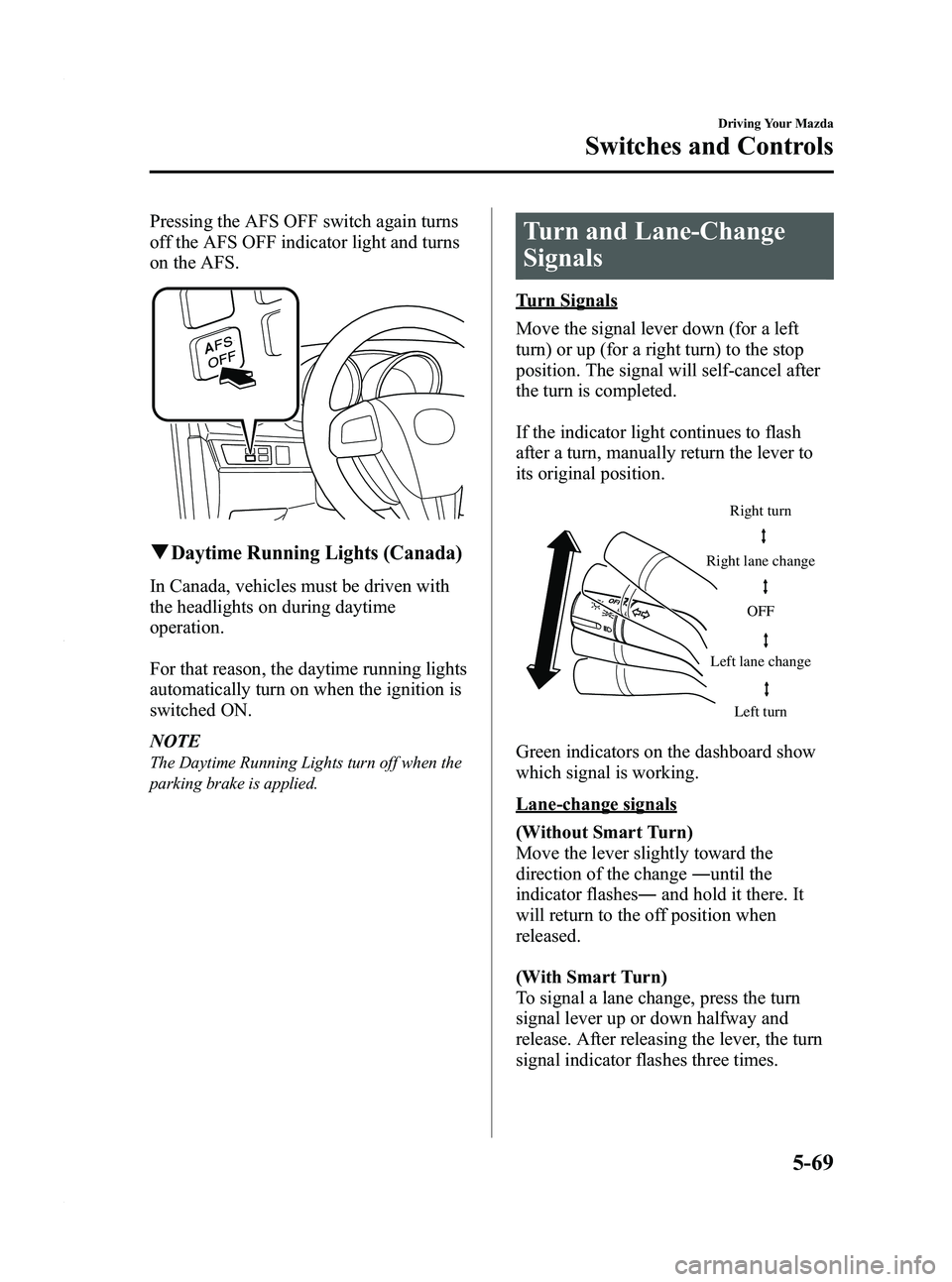
Black plate (233,1)
Pressing the AFS OFF switch again turns
off the AFS OFF indicator light and turns
on the AFS.
qDaytime Running Lights (Canada)
In Canada, vehicles must be driven with
the headlights on during daytime
operation.
For that reason, the daytime running lights
automatically turn on when the ignition is
switched ON.
NOTE
The Daytime Running Lights turn off when the
parking brake is applied.
Turn and Lane-Change
Signals
Turn Signals
Move the signal lever down (for a left
turn) or up (for a right turn) to the stop
position. The signal will self-cancel after
the turn is completed.
If the indicator light continues to flash
after a turn, manually return the lever to
its original position.
Right turnLeft turn
Right lane change
Left lane change OFF
Green indicators on the dashboard show
which signal is working.
Lane-change signals
(Without Smart Turn)
Move the lever slightly toward the
direction of the change
―until the
indicator flashes ―and hold it there. It
will return to the off position when
released.
(With Smart Turn)
To signal a lane change, press the turn
signal lever up or down halfway and
release. After releasing the lever, the turn
signal indicator flashes three times.
Driving Your Mazda
Switches and Controls
5-69
Mazda3_8BY6-EA-11F_Edition3 Page233
Thursday, March 1 2012 10:17 AM
Form No.8BY6-EA-11F
Page 238 of 528
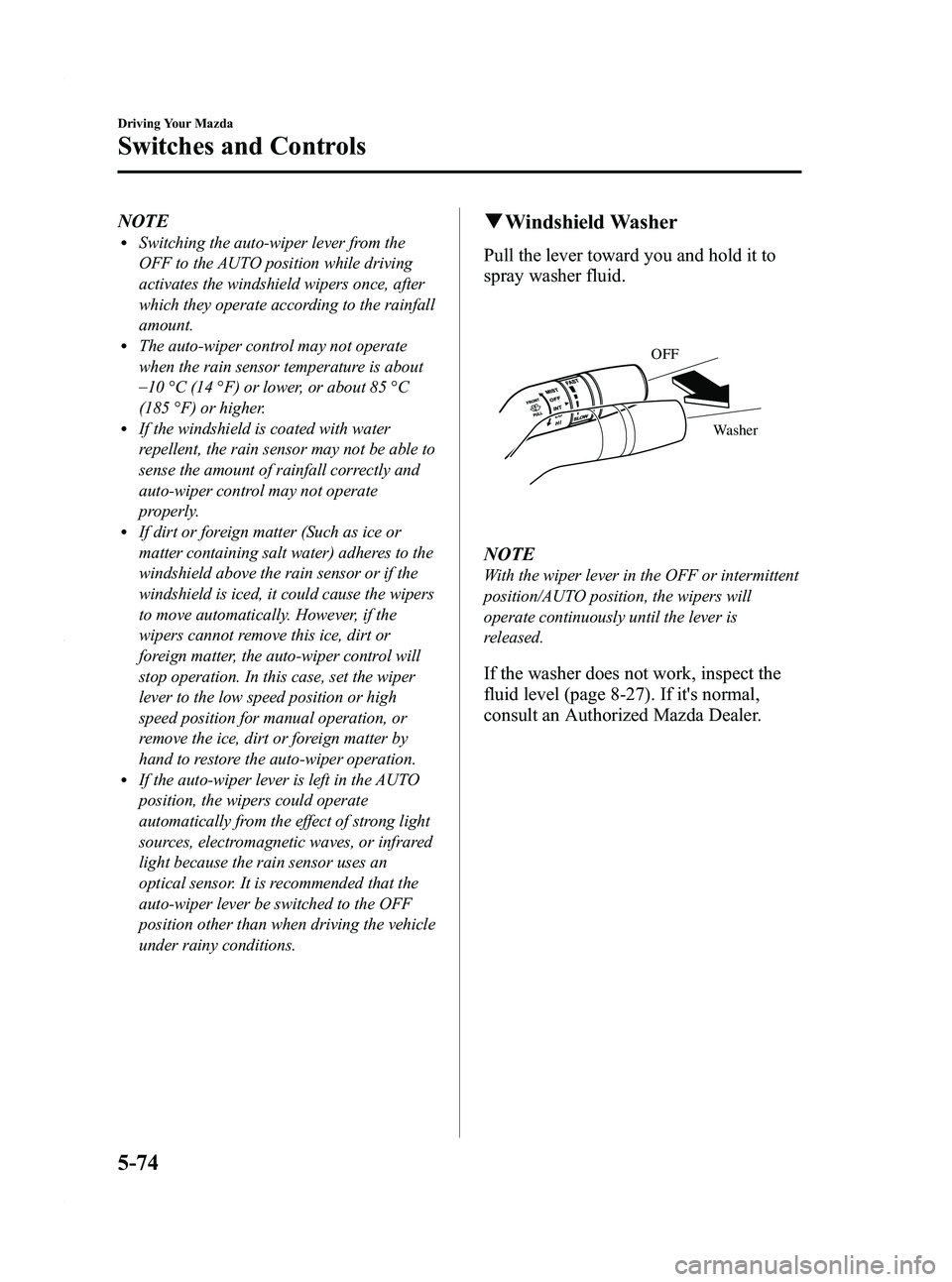
Black plate (238,1)
NOTElSwitching the auto-wiper lever from the
OFF to the AUTO position while driving
activates the windshield wipers once, after
which they operate according to the rainfall
amount.
lThe auto-wiper control may not operate
when the rain sensor temperature is about
_10 °C (14 °F) or lower, or about 85 °C
(185 °F) or higher.
lIf the windshield is coated with water
repellent, the rain sensor may not be able to
sense the amount of rainfall correctly and
auto-wiper control may not operate
properly.
lIf dirt or foreign matter (Such as ice or
matter containing salt water) adheres to the
windshield above the rain sensor or if the
windshield is iced, it could cause the wipers
to move automatically. However, if the
wipers cannot remove this ice, dirt or
foreign matter, the auto-wiper control will
stop operation. In this case, set the wiper
lever to the low speed position or high
speed position for manual operation, or
remove the ice, dirt or foreign matter by
hand to restore the auto-wiper operation.
lIf the auto-wiper lever is left in the AUTO
position, the wipers could operate
automatically from the effect of strong light
sources, electromagnetic waves, or infrared
light because the rain sensor uses an
optical sensor. It is recommended that the
auto-wiper lever be switched to the OFF
position other than when driving the vehicle
under rainy conditions.
q Windshield Washer
Pull the lever toward you and hold it to
spray washer fluid.
Washer
OFF
NOTE
With the wiper lever in the OFF or intermittent
position/AUTO position, the wipers will
operate continuously until the lever is
released.
If the washer does not work, inspect the
fluid level (page 8-27). If it's normal,
consult an Authorized Mazda Dealer.
5-74
Driving Your Mazda
Switches and Controls
Mazda3_8BY6-EA-11F_Edition3 Page238
Thursday, March 1 2012 10:17 AM
Form No.8BY6-EA-11F
Page 241 of 528
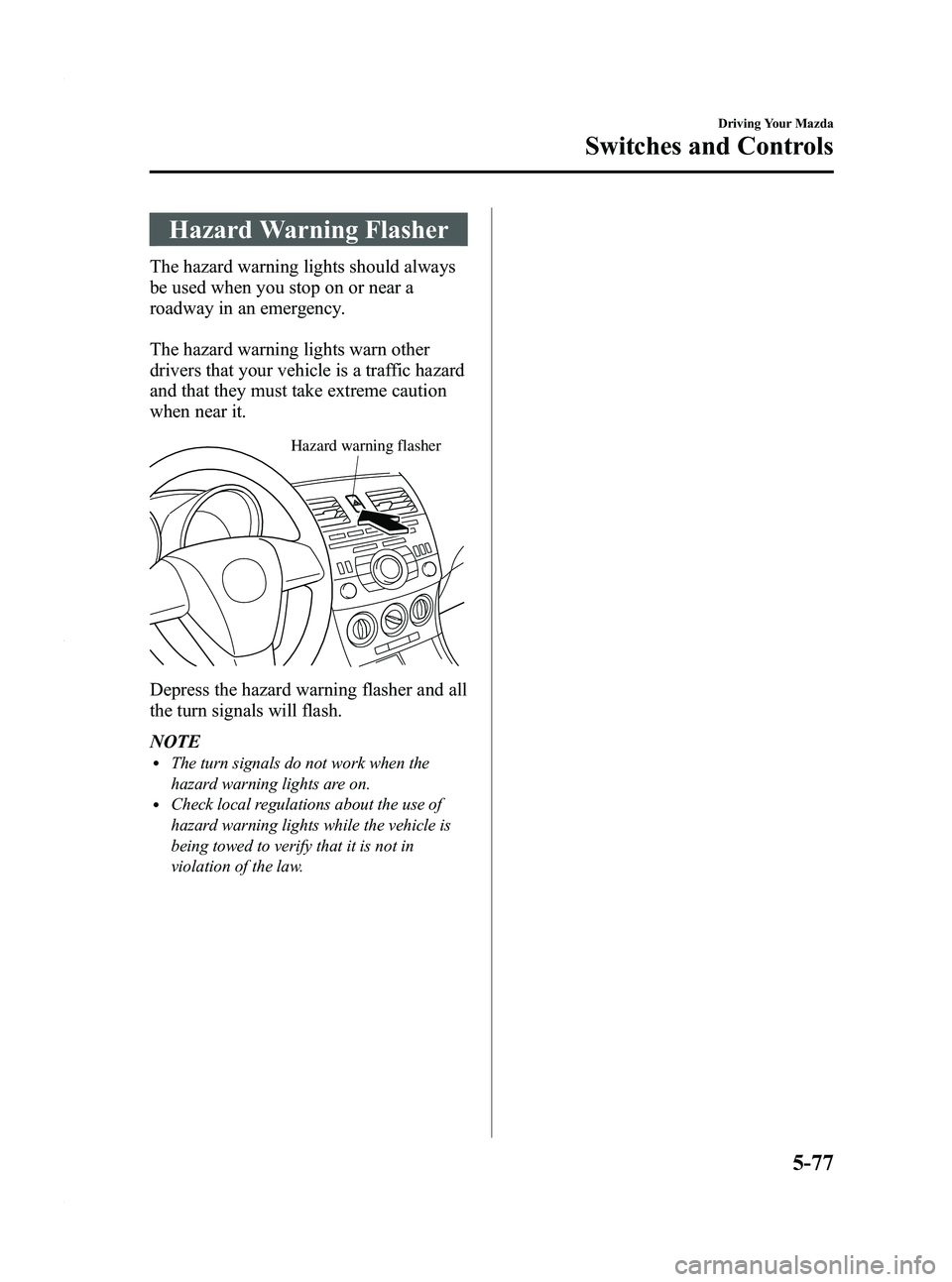
Black plate (241,1)
Hazard Warning Flasher
The hazard warning lights should always
be used when you stop on or near a
roadway in an emergency.
The hazard warning lights warn other
drivers that your vehicle is a traffic hazard
and that they must take extreme caution
when near it.
Hazard warning flasher
Depress the hazard warning flasher and all
the turn signals will flash.
NOTE
lThe turn signals do not work when the
hazard warning lights are on.
lCheck local regulations about the use of
hazard warning lights while the vehicle is
being towed to verify that it is not in
violation of the law.
Driving Your Mazda
Switches and Controls
5-77
Mazda3_8BY6-EA-11F_Edition3 Page241
Thursday, March 1 2012 10:17 AM
Form No.8BY6-EA-11F
Page 261 of 528
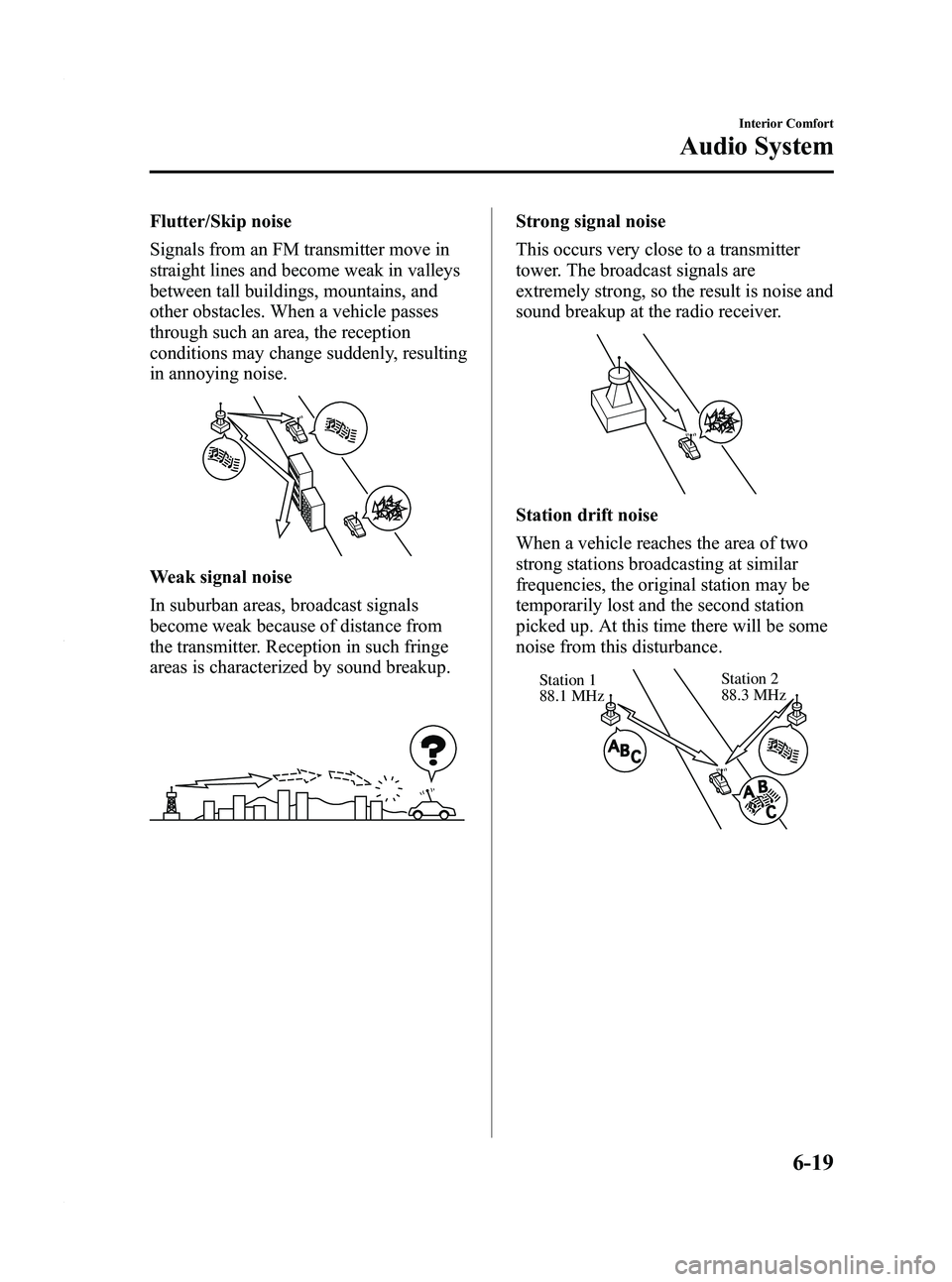
Black plate (261,1)
Flutter/Skip noise
Signals from an FM transmitter move in
straight lines and become weak in valleys
between tall buildings, mountains, and
other obstacles. When a vehicle passes
through such an area, the reception
conditions may change suddenly, resulting
in annoying noise.
Weak signal noise
In suburban areas, broadcast signals
become weak because of distance from
the transmitter. Reception in such fringe
areas is characterized by sound breakup.
Strong signal noise
This occurs very close to a transmitter
tower. The broadcast signals are
extremely strong, so the result is noise and
sound breakup at the radio receiver.
Station drift noise
When a vehicle reaches the area of two
strong stations broadcasting at similar
frequencies, the original station may be
temporarily lost and the second station
picked up. At this time there will be some
noise from this disturbance.
Station 2
88.3 MHz
Station 1
88.1 MHz
Interior Comfort
Audio System
6-19
Mazda3_8BY6-EA-11F_Edition3 Page261
Thursday, March 1 2012 10:17 AM
Form No.8BY6-EA-11F
Page 354 of 528
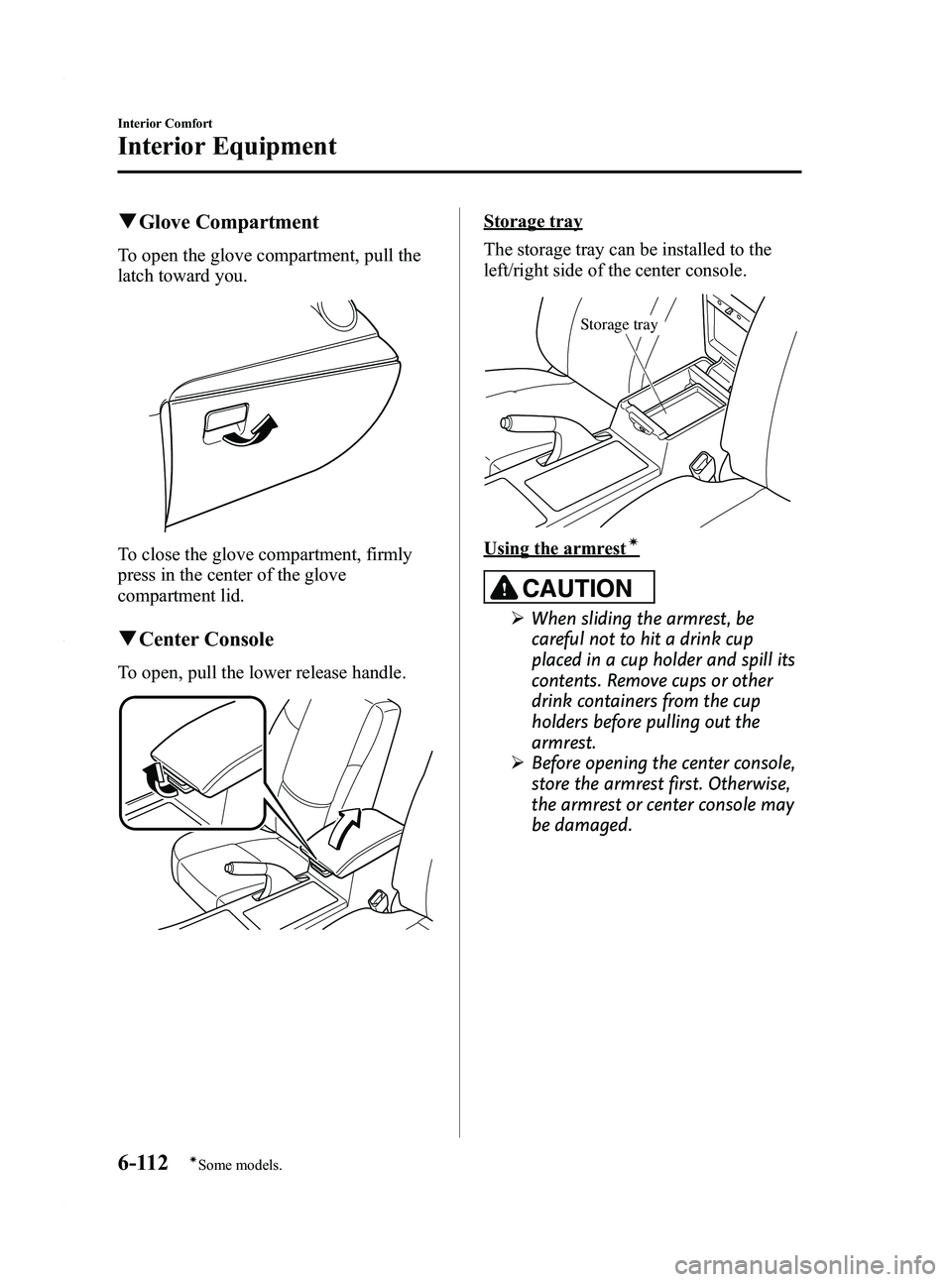
Black plate (354,1)
qGlove Compartment
To open the glove compartment, pull the
latch toward you.
To close the glove compartment, firmly
press in the center of the glove
compartment lid.
qCenter Console
To open, pull the lower release handle.
Storage tray
The storage tray can be installed to the
left/right side of the center console.
Storage tray
Using the armrestí
CAUTION
Ø When sliding the armrest, be
careful not to hit a drink cup
placed in a cup holder and spill its
contents. Remove cups or other
drink containers from the cup
holders before pulling out the
armrest.
Ø Before opening the center console,
store the armrest first. Otherwise,
the armrest or center console may
be damaged.
6-112
Interior Comfort
íSome models.
Interior Equipment
Mazda3_8BY6-EA-11F_Edition3 Page354
Thursday, March 1 2012 10:18 AM
Form No.8BY6-EA-11F
Page 359 of 528
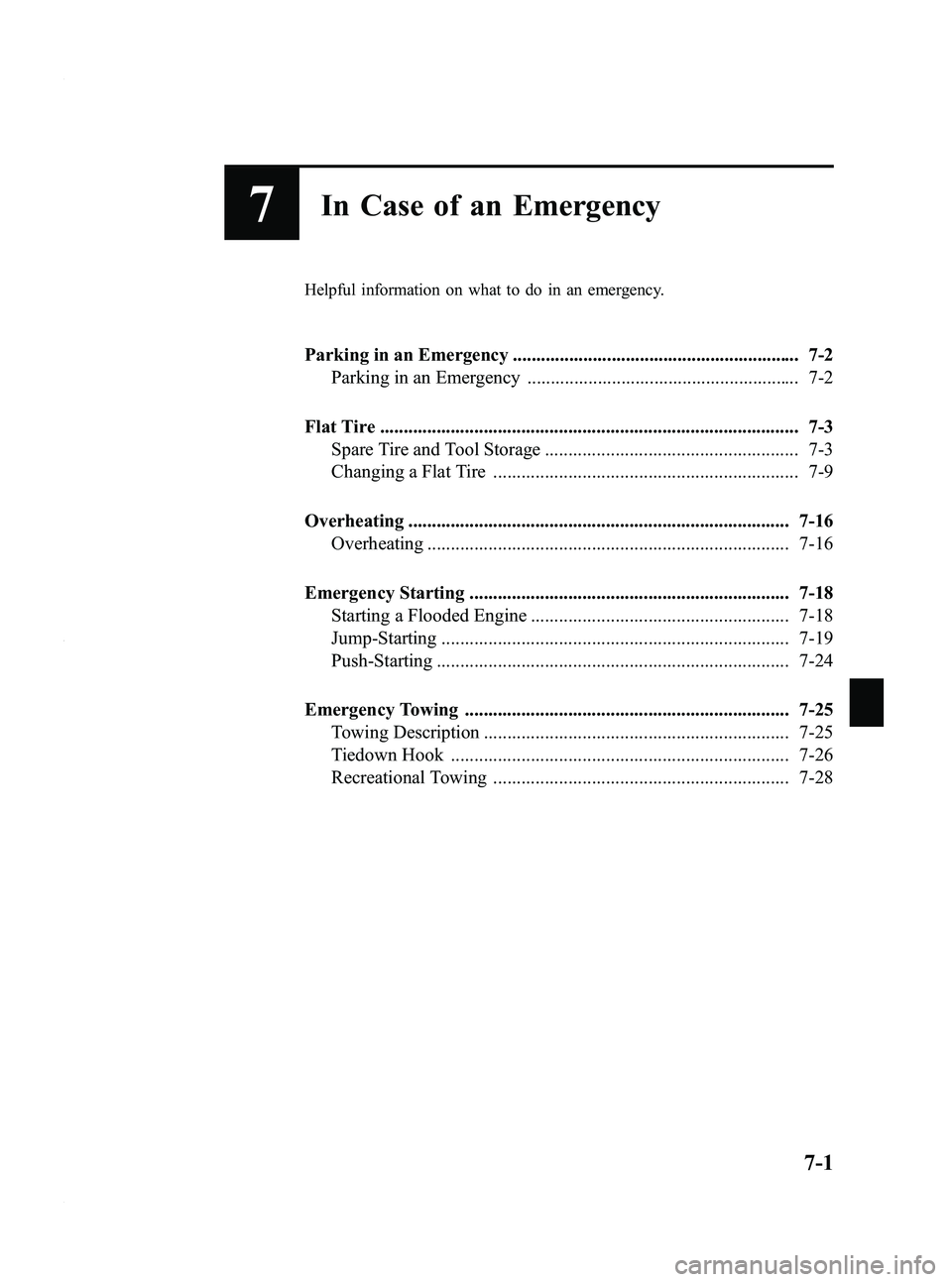
Black plate (359,1)
7In Case of an Emergency
Helpful information on what to do in an emergency.
Parking in an Emergency ............................................................. 7-2Parking in an Emergency .......................................................... 7-2
Flat Tire ......................................................................................... 7-3 Spare Tire and Tool Storage ...................................................... 7-3
Changing a Flat Tire ................................................................. 7-9
Overheating ................................................................................. 7-16 Overheating ............................................................................. 7-16
Emergency Starting .................................................................... 7-18 Starting a Flooded Engine ....................................................... 7-18
Jump-Starting .......................................................................... 7-19
Push-Starting ........................................................................... 7-24
Emergency Towing ..................................................................... 7-25 Towing Description ................................................................. 7-25
Tiedown Hook ........................................................................ 7-26
Recreational Towing ............................................................... 7-28
7-1
Mazda3_8BY6-EA-11F_Edition3 Page359
Thursday, March 1 2012 10:18 AM
Form No.8BY6-EA-11F
Page 360 of 528
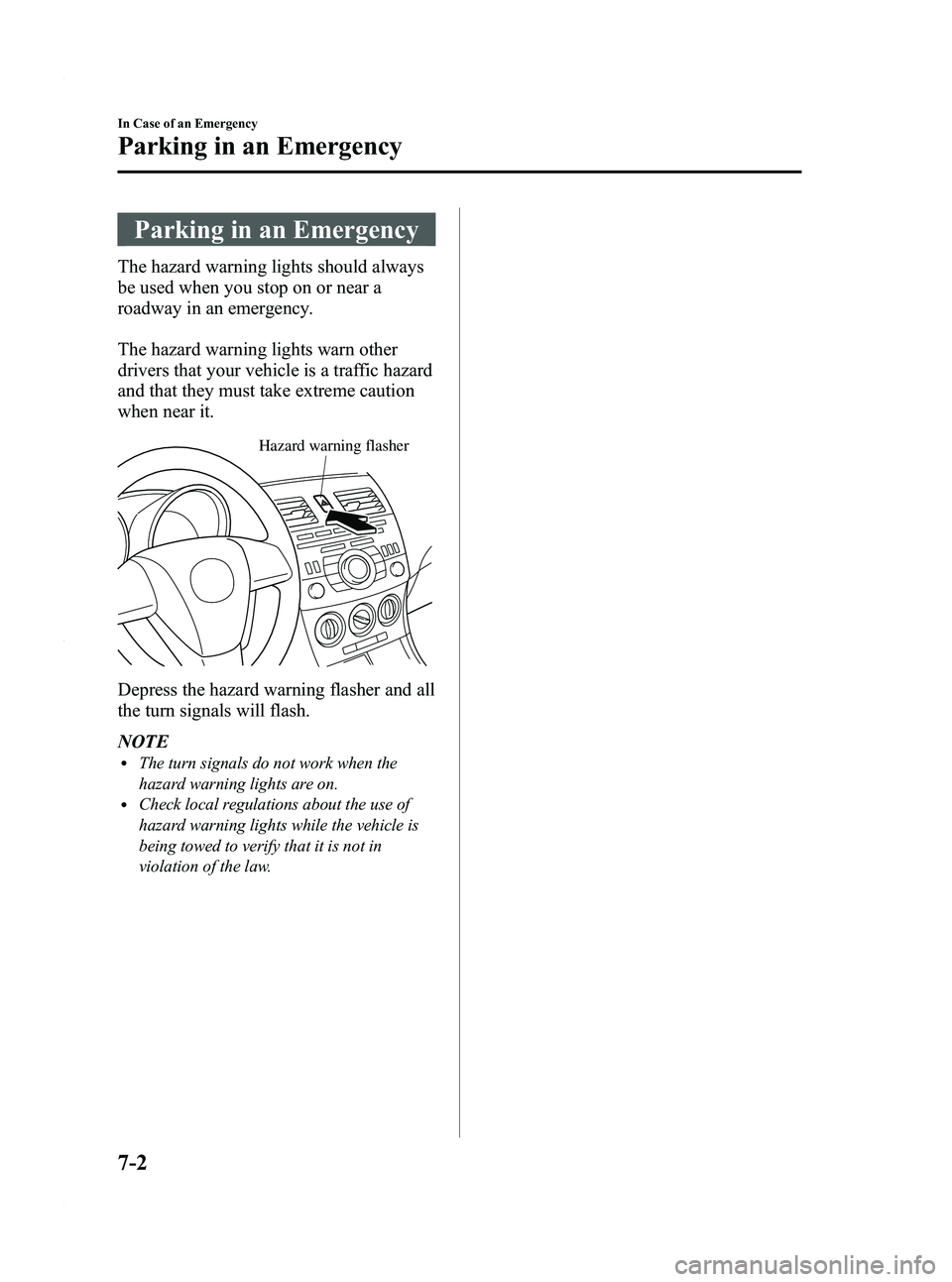
Black plate (360,1)
Parking in an Emergency
The hazard warning lights should always
be used when you stop on or near a
roadway in an emergency.
The hazard warning lights warn other
drivers that your vehicle is a traffic hazard
and that they must take extreme caution
when near it.
Hazard warning flasher
Depress the hazard warning flasher and all
the turn signals will flash.
NOTE
lThe turn signals do not work when the
hazard warning lights are on.
lCheck local regulations about the use of
hazard warning lights while the vehicle is
being towed to verify that it is not in
violation of the law.
7-2
In Case of an Emergency
Parking in an Emergency
Mazda3_8BY6-EA-11F_Edition3 Page360
Thursday, March 1 2012 10:18 AM
Form No.8BY6-EA-11F
Page 382 of 528
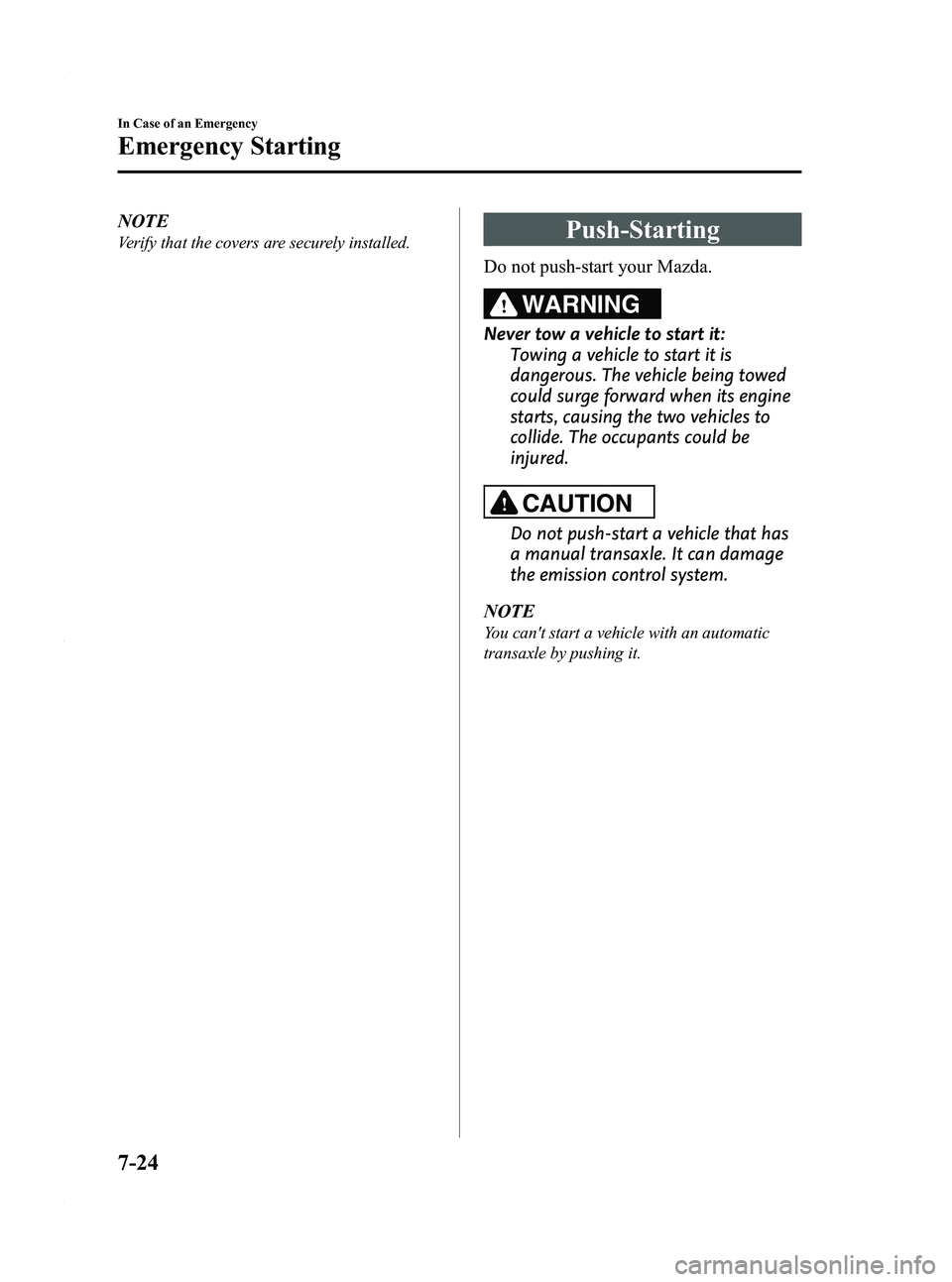
Black plate (382,1)
NOTE
Verify that the covers are securely installed.Push-Starting
Do not push-start your Mazda.
WARNING
Never tow a vehicle to start it:Towing a vehicle to start it is
dangerous. The vehicle being towed
could surge forward when its engine
starts, causing the two vehicles to
collide. The occupants could be
injured.
CAUTION
Do not push-start a vehicle that has
a manual transaxle. It can damage
the emission control system.
NOTE
You can't start a vehicle with an automatic
transaxle by pushing it.
7-24
In Case of an Emergency
Emergency Starting
Mazda3_8BY6-EA-11F_Edition3 Page382
Thursday, March 1 2012 10:18 AM
Form No.8BY6-EA-11F
Page 383 of 528
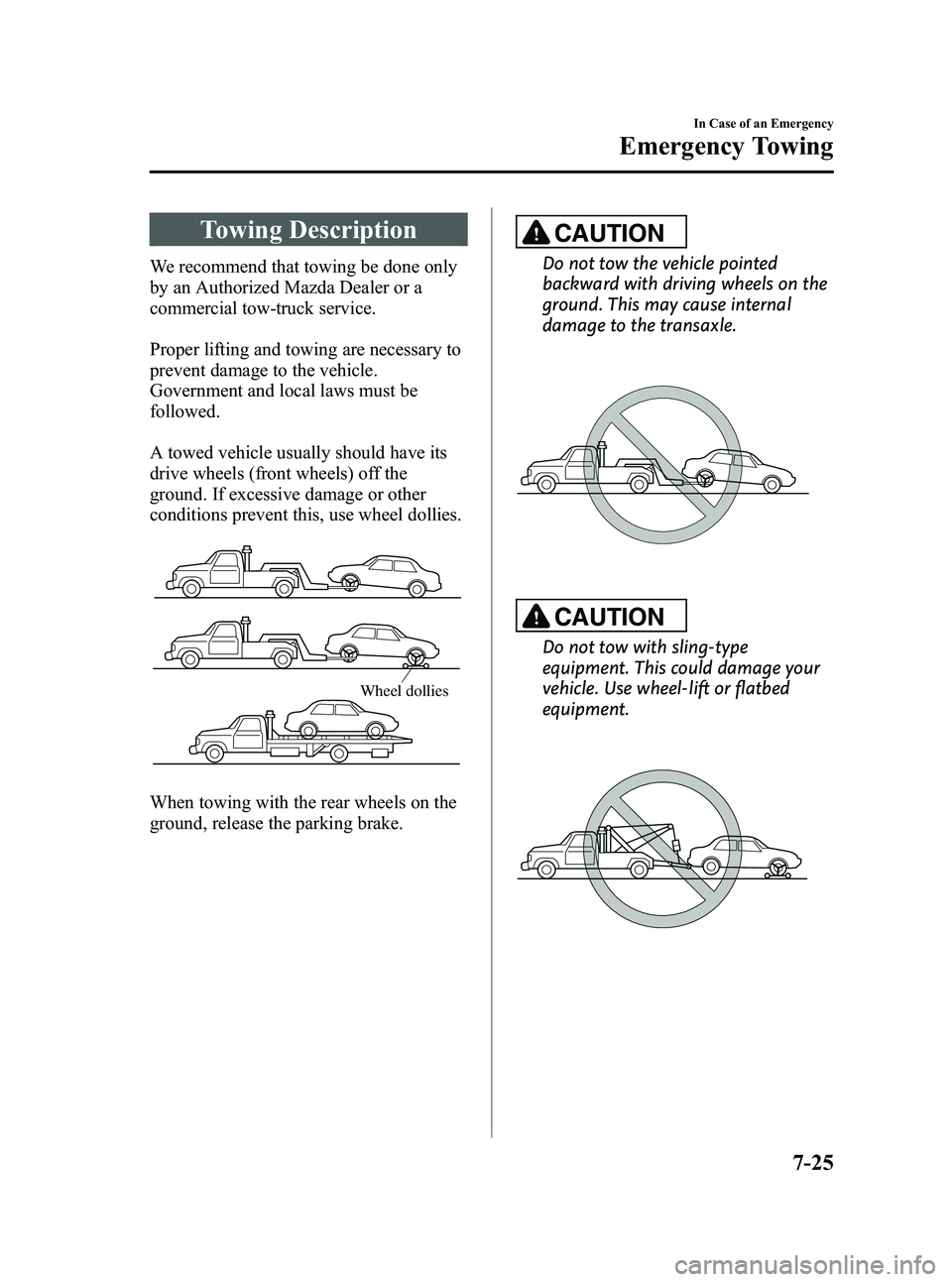
Black plate (383,1)
Towing Description
We recommend that towing be done only
by an Authorized Mazda Dealer or a
commercial tow-truck service.
Proper lifting and towing are necessary to
prevent damage to the vehicle.
Government and local laws must be
followed.
A towed vehicle usually should have its
drive wheels (front wheels) off the
ground. If excessive damage or other
conditions prevent this, use wheel dollies.
Wheel dollies
When towing with the rear wheels on the
ground, release the parking brake.
CAUTION
Do not tow the vehicle pointed
backward with driving wheels on the
ground. This may cause internal
damage to the transaxle.
CAUTION
Do not tow with sling-type
equipment. This could damage your
vehicle. Use wheel-lift or flatbed
equipment.
In Case of an Emergency
Emergency Towing
7-25
Mazda3_8BY6-EA-11F_Edition3 Page383
Thursday, March 1 2012 10:18 AM
Form No.8BY6-EA-11F
Page 384 of 528
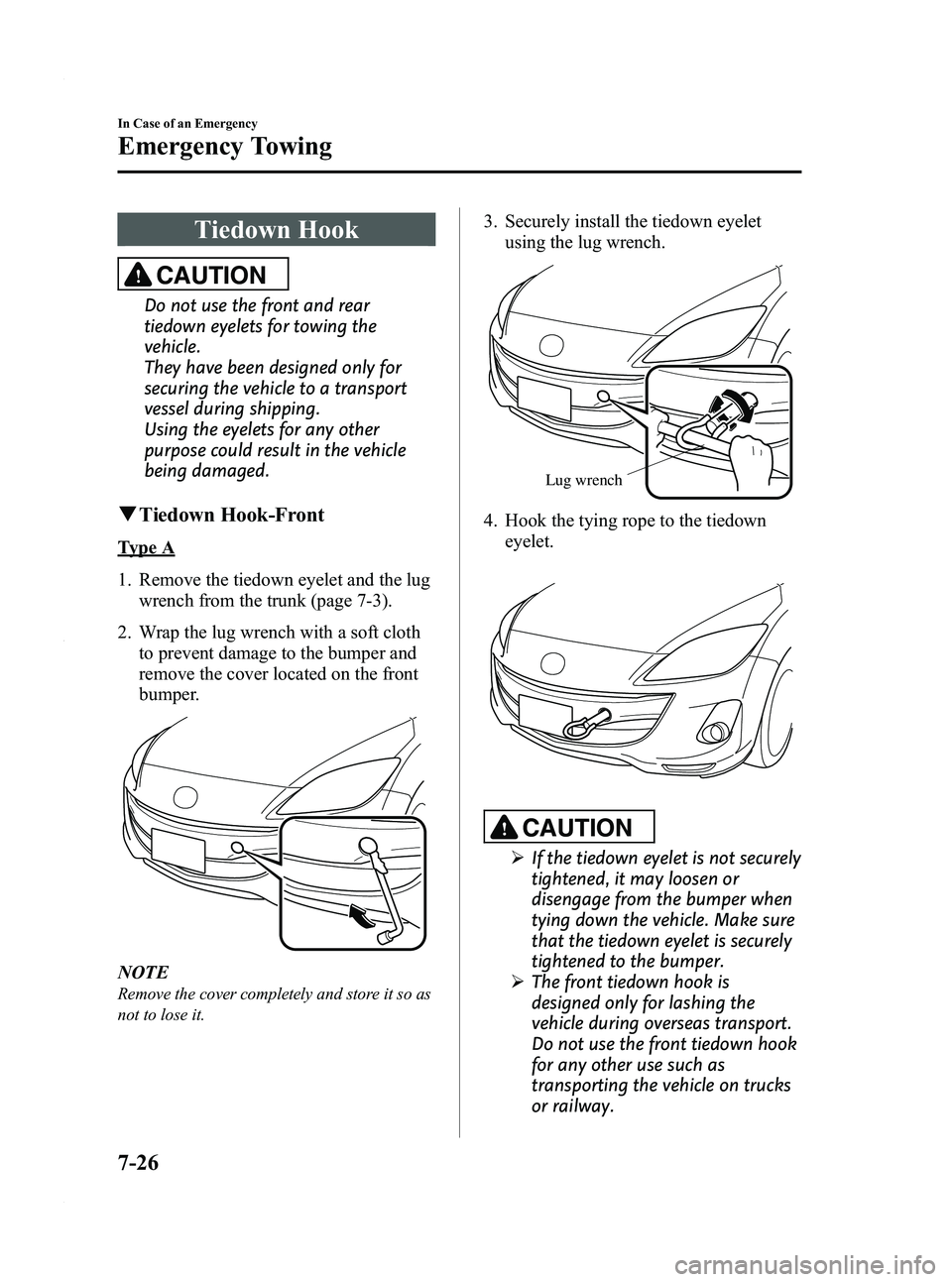
Black plate (384,1)
Tiedown Hook
CAUTION
Do not use the front and rear
tiedown eyelets for towing the
vehicle.
They have been designed only for
securing the vehicle to a transport
vessel during shipping.
Using the eyelets for any other
purpose could result in the vehicle
being damaged.
qTiedown Hook-Front
Type A
1. Remove the tiedown eyelet and the lug
wrench from the trunk (page 7-3).
2. Wrap the lug wrench with a soft cloth to prevent damage to the bumper and
remove the cover located on the front
bumper.
NOTE
Remove the cover completely and store it so as
not to lose it.
3. Securely install the tiedown eyeletusing the lug wrench.
Lug wrench
4. Hook the tying rope to the tiedown
eyelet.
CAUTION
ØIf the tiedown eyelet is not securely
tightened, it may loosen or
disengage from the bumper when
tying down the vehicle. Make sure
that the tiedown eyelet is securely
tightened to the bumper.
Ø The front tiedown hook is
designed only for lashing the
vehicle during overseas transport.
Do not use the front tiedown hook
for any other use such as
transporting the vehicle on trucks
or railway.
7-26
In Case of an Emergency
Emergency Towing
Mazda3_8BY6-EA-11F_Edition3 Page384
Thursday, March 1 2012 10:18 AM
Form No.8BY6-EA-11F